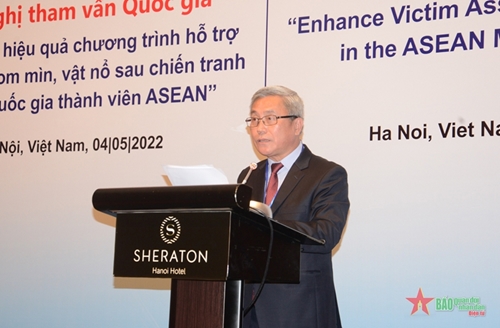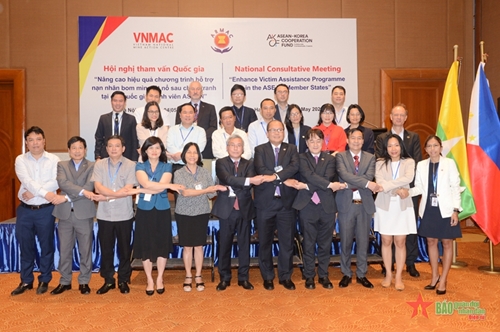    |
 |
|
Senior Colonel Nguyen Hanh Phuc addresses the event. |
Senior Colonel Nguyen Hanh Phuc, Permanent Deputy General Director of VNMAC, and Prum Sunonpraseth, ARMAC Executive Director, co-chaired the event under the theme “Enhance victim assistance program in the ASEAN member states.”
In his opening remarks, Colonel Phuc stressed that Vietnam is one of the countries heavily affected by war-left UXO. During decades of war, Vietnam suffered millions of tons of bombs and ammunition. More than 4 million people were killed and over 60,000 people were injured during that time. Post-war UXO has caused not only dangers to people’s lives, but also negative impacts on the country’s socio-economic development.
Many Vietnamese UXO victims have faced difficulties in social life. Thus, the joining hands of nations, international organizations, sponsors to support victims and mine action programs is significant, practical, humanitarian, and necessary.
To make the assistance effective, ARMAC and ASEAN member states have been jointly carrying out a project entitled “Enhance victim assistance program in the ASEAN member states.” The project, starting in January 2021 under the auspices of ASEAN-Republic of Korea (RoK) cooperation fund, is expected to be completed in January 2024. This national consultative meeting is among first activities of the project with the aim of establishing a regional assistance system for UXO victims.
In the first stage of the project, ARMAC targets to form a regional assistance network via the organization of five national consultative meetings, one regional consultative meeting and one regional seminar.
This national consultative meeting aimed to share Vietnam’s experience and knowledge of giving assistance to the victims. The meeting also targeted to boost international integration and cooperation in Vietnam’s mine action, as well as demonstrate Vietnam’s role in building ARMAC and mine action in ASEAN.
    |
 |
|
Delegates in a joint photo |
As scheduled, in one-day meeting, participants presented and discussed several major contents such as an integrated approach to victim assistance; best practices and challenges in adopting an integrated country-level approach; national perspectives on victim assistance and approaches to victim assistance (services, challenges, role and responsibility); global perspective on victim assistance and introduction of section 13.10 of the International Mine Action Standards (IMAS) related to victim assistance; and the establishment of a regional victim assistance system, and more.
Translated by Mai Huong